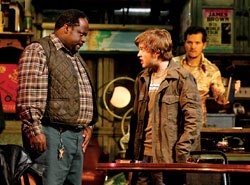In today’s Wall Street Journal “Sightings” column, I explain how American theaters rarely perform older plays—and what effect that has on our theatrical culture. Here’s an excerpt.
* * *
The most revealing news of the 2019-20 theatrical season was the announcement last month of a pair of big-ticket revivals, Edward Albee’s “Who’s Afraid of Virginia Woolf?” and David Mamet’s “American Buffalo,” both of which are set to open on Broadway next April. What made it so noteworthy is that “Virginia Woolf,” first performed in 1962, has already been done there four times, most recently in 2012-13, while “American Buffalo,” first performed in 1975, has been done three times, most recently in 2008.

Why do these two well-worn plays get revived so often—and why are they coming back to Broadway so soon? Three interlocking reasons come to mind:
• Unlike most older American plays, they’re small-cast one-set shows (“Virginia Woolf” calls for four actors, “American Buffalo” for four) that can be produced cheaply.
• They contain flashy roles irresistible to well-known male actors looking for a challenge (“American Buffalo” will star Sam Rockwell, “Virginia Woolf” Rupert Everett).
• They’re known by name to everyone who knows anything about 20th-century theater, in part because both plays were filmed to outstanding effect.
Above all, though, “Who’s Afraid of Virginia Woolf?” and “American Buffalo” are full-fledged American classics—and if you define an “American classic” as a great play that is revived with reasonable regularity, then only a small number of 20th-century plays fill that bill. But that’s not because of a shortage of great modern plays: It’s because our theaters tend not to revive older plays, classic or otherwise
* * *
Read the whole thing here.A scene from the 2012 Broadway revival of Edward Albee’s “Who’s Afraid of Virginia Woolf?” (as previously mounted at Washington’s Arena Stage). Tracy Letts and Amy Morton play George and Martha:
